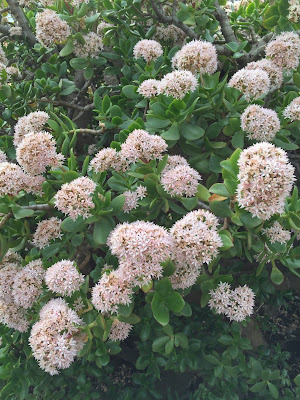The Cango Caves are located in Precambrian limestones at the foothills of the Swartberg range in the Western Cape Province of South Africa. The main cave is the best known. Although the extensive system of tunnels and chambers goes on for over two and a half miles, only about a quarter of this is open to visitors. Many of the caves have been closed to protect them from the changes that come when people are permitted access.
Cango Caves offers a historic tour (which we took) and an adventure tour which, frankly, didn't sound that appealing. You end up making your way through small openings which, when described, sounded something like the process of being born. Chambers were illuminated one by one as we entered, with dramatic effect. Once we circled back to the main chamber, we stopped and sang Pavel Tchesnokov's Salvation is Created. Coincidentally, one of the formations in that chamber is known as the "pipe organ." The chamber was once home to a concert series but it was ended after audience members wandered off and defaced areas of the caves, scrawling graffiti and doing other damage. The stage was still there with risers built in for a choir.
Then it was time for lunch. As I'm sure you've guessed, ostrich was on the menu. It was delicious, as were all the accompaniments. I'm told that ostrich meat is available here at home. Here's a recipe to try (we couldn't get the recipe for the dish we had at the farm–family secret).
Marinated Ostrich Steak
YIELD:4 servings
Ingredients
• 3/4 cup vegetable oil
• 1/3 cup soy sauce
• 1/4 cup cider or white wine vinegar
• 3 tablespoons lemon juice
• 2 tablespoons Worcestershire sauce
• 1 tablespoon ground mustard
• 1 teaspoon salt
• 1 teaspoon pepper
• 1 teaspoon dried parsley flakes
• 1/2 teaspoon garlic powder
• 4 ostrich or beef tenderloin steaks (4 ounces each)
Directions
1. In a resealable plastic bag or shallow glass container, combine the first 10 ingredients; mix well. Add meat to marinade and turn to coat. Seal bag or cover container; refrigerate overnight, turning meat occasionally. Drain and discard marinade. Broil or grill, covered, over medium heat for 5 minutes. Turn and cook 6-8 minutes longer or until meat reaches desired doneness (for medium-rare, a meat thermometer should read 145°; medium, 160°; and well done, 170°). Yield: 4 servings.



















No comments:
Post a Comment